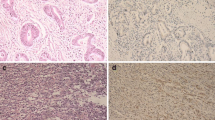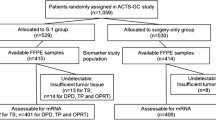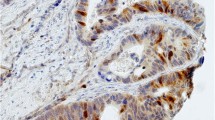Abstract
Purpose
It is well known that both gastric and intestinal phenotypic markers are expressed in gastric carcinomas, irrespective of their histological type. In the present study, the associations among phenotypic marker expression of gastric carcinomas, tumor thymidylate synthase (TS) expression, and the chemotherapeutic response to 5-fluorouracil (5-FU) were examined.
Methods
The gastric and intestinal phenotypic marker expression of the tumor was determined by the combination of the expression of human gastric mucin (HGM), MUC6, MUC2, and CD10, and was evaluated in comparison with tumor TS expression in 137 advanced gastric carcinomas in 137 patients (75 with postoperative chemotherapy with 5-FU and 62 without postoperative chemotherapy). Tumors were classified into the gastric- (G-), gastric and intestinal mixed- (GI-), intestinal- (I-), or unclassified- (UC-) phenotype according to the immunopositivity of HGM, MUC6, MUC2, and CD10 stainings. The associations among the gastric and intestinal phenotypic marker expression of the tumor, tumor TS expression, effect of postoperative chemotherapy with 5-FU, and the patient’s prognosis were examined.
Results
Of the 137 gastric carcinomas, 48 (35.0%), 58 (42.3%), 23 (16.8%), and 8 (5.8%)were classified as the G-, GI-, I- and UC-phenotype, respectively. The high TS expression of more than 25% tumor cell positivity was found in 25 (52.1%) of the 48 G-phenotype tumors, 39 (67.2%) of the 58 GI-phenotype tumors, 18 (78.3%) of the 23 I-phenotype tumors, and 4 (50.0%) of the 8 UC-phenotype tumors. The I-phenotype tumors were significantly correlated with the higher rate of the high TS expression as compared with the G-phenotype tumors (P<0.05). Among 48 patients with the G-phenotype tumor, the 5-year survival rate in patients with and without postoperative chemotherapy was 39.7 and 27.8%, respectively. The patients with postoperative chemotherapy had a significantly better prognosis than those without postoperative chemotherapy (P<0.05). Conversely, there were no significant correlations between the presence of postoperative chemotherapy and the patient’s prognosis among patients with GI-, I-, and UC-phenotype tumors.
Conclusions
These results indicate that postoperative chemotherapy with 5-FU could be effective for patients with the G-phenotype tumor, since the incidence of intratumoral expression of TS, the target enzyme of 5-FU, is significantly low in G-phenotype tumors.





Similar content being viewed by others
References
Albarracin CT, Jafri J, Montag AG, Hart J, Kuan SF (2000) Differential expression of MUC2 and MUC5AC mucin genes in primary ovarian and metastatic colonic carcinoma. Hum Pathol 31:672–677
Bara J, Gautier R, Mouradian P, Decaens C, Daher N (1991) Oncofetal mucin M1 epitope family: characterization and expression during colonic carcinogenesis. Int J Cancer 47:304–310
Bolos C de, Garrido M, Real FX (1995) MUC6 apomucin shows a distinct normal tissue distribution that correlates with Lewis antigen expression in the human stomach. Gastroenterology 109:723–734
Egashira Y, Shimoda T, Ikegami M (1999) Mucin histochemical analysis of minute gastric differentiated adenocarcinoma. Pathol Int 49:55–61
Endoh Y, Tamura G, Watanabe H, Ajioka Y, Motoyama T (1999) The common 18-base pair deletion at codons 418–423 of the E-cadherin gene undifferentiated-type adenocarcinomas and intramucosal precancerous lesions of the stomach with the features of gastric foveolar epithelium. J Pathol 189:201–206
Hsu SM, Raine L, Fanger H (1981) Use of avidin–biotin peroxidase complex (ABC) in immunoperoxidase techniques: a comparison between ABC and unlabeled antibody (PAP) procedures. J Histochem Cytochem 29:577–580
Japanese Research Society for Gastric Cancer (1995) Japanese classification of gastric carcinoma, 1st English edn. Kanehara and Co., Tokyo
Johnston PG, Lenz HJ, Leichman CG, Dananberg KD, Allegra CJ, Danenberg PV, Leichman L (1995) Thymidylate synthase gene and protein expression correlate and are associated with response to 5-fluorouracil in human colorectal and gastric tumors. Cancer Res 55:1407–1412
Kaplan EL, Meier P (1958) Nonparametric estimation from incomplete observations. J Am Stat Assoc 53:457–481
Kim YS, Gum JR (1995) Diversity of mucin genes, structure, function, and expression. Gastroenterology 109:999–1013
Koseki K, Takizawa T, Koike M, Ito M, Nihei Z, Sugihara K (2000) Distinction of differentiated type early gastric carcinoma with gastric type mucin expression. Cancer 89:724–732
Kuniyasu T, Nakamura T, Tabuchi Y, Kuroda Y (1998) Immunohistochemical evaluation of thymidylate synthase in gastric carcinoma using a new polyclonal antibody: the clinical role of thymidylate synthase as a prognostic indicator and its therapeutic usefulness. Cancer 83:1300–1306
Larsson PA, Carlson G, Gustavsson B, Spears CP (1996) Thymidylate synthase in advanced gastrointestinal and breast cancers. Acta Oncol 35:469–472
Lauren P (1965) The two histological main types of gastric carcinoma: diffuse and so-called intestinal-type carcinoma. Acta Pathol Microbiol Scand 64:31–49
Maehara K, Okuyama T, Oshiro T, Baba H, Anai H, Akazawa K, Sugimachi K (1993) Early carcinoma of the stomach. Surg Gynecol Obstet 177:593–597
Nakamura K, Sugano H, Takagi K (1968) Carcinoma of the stomach in incipient phase: its histogenesis and histological appearances. GANN 59:251–258
Nakamura K, Ueyama T, Yao T, Xuan ZX, Ambe K, Adachi Y, Yakeishi Y, Matsukura A, Enjoji M (1992) Pathology and prognosis of gastric carcinoma: findings in 10,000 patients who underwent primary gastrectomy. Cancer 70:1030–1037
Okabe K, Tsujimoto H, Fukushima M (1997) Preoperation of the antibodies against recombinant human thymidylate synthase for the detection of its intratumoral levels and the application to sensitivity-study of 5-fuorouracil. Oncol Rep 4:685–690
Peto R, Pike MC, Armitage P, Breslow NE, Cox DR, Howard SV, Mantel N, McPherson K, Peto J, Smith PG (1977) Design and analysis of randomized clinical trials requiring prolonged observation of each patient. II: Analysis and examples. Br J Cancer 35:1–39
Pinedo HM, Peters GFJ (1988) Fluorouracil: biochemistry and pharmacology. J Clin Oncol 6:1653–1664
Preusser P, Achtterrath W, Wilke H, Lenaz L, Fink U, Heinicke A, Meyer J, Bunte H (1988) Chemotherapy of gastric cancer. Cancer Treat Rev 15:257–277
Reis CA, David L, Correa P, Carneiro F, Bolos C de, Garcia E, Mandel U, Clausen H, Sobrinho-Simoes M (1995) Intestinal metaplasia of human stomach displays distinct pattern of mucin (MUC1, MUC2, MUC5AC, and MUC6) expression. Cancer Res 59:1003–1007
Ronco P, Allegri L, Melcion C, Pirotsky E, Appay MD, Bariety J, Pontillon F, Verroust P (1984) A monoclonal antibody to brush border and passive nephritis. Clin Exp Immunol 55:319–332
Saito A, Shimoda T, Nakanishi Y, Ochiai A, Toda G (2000) Histologic heterogeneity and mucin phenotypic expression in early gastric cancer. Pathol Int 51:165–171
Sakamoto H, Yonezawa S, Utsunomiya T, Tanaka S, Kim YS, Sato E (1997) Mucin antigen expression in gastric carcinomas of young and old adults. Hum Pathol 28:1056–1065
Sasaki I, Yao T, Nawata H, Tsuneyoshi M (1999) Minute gastric carcinoma of differentiated type with special reference to the significance of intestinal metaplasia, proliferative zone, and p53 protein during tumor development. Cancer 85:1719–1729
Shi SR, Key ME, Karla KL (1991) Antigen retrieval in formalin-fixed, paraffin-embedded tissues: an enhancement method for immunohistochemical staining based on microwave oven heating of tissue sections. J Histochem Cytochem 39:741–748
Tajima Y, Nakanishi Y, Yoshino T, Kokawa A, Kusano M, Shimoda T (2001a) Clinicopathological study of early adenocarcinoma of the gastric cardia: Comparison with early adenocarcinoma of the distal stomach and esophagus. Oncology 61:1–9
Tajima Y, Shimoda T, Nakanishi Y, Yokoyama N, Tanaka T, Shimizu K, Saito T, Kawamura M, Kusano M, Kumagai K (2001b) Gastric and intestinal phenotypic marker expression in gastric carcinomas and their prognostic significance: immunohistochemical analysis of 136 lesions. Oncology 61:212–220
Tatematsu M, Ichinose M, Miki K, Hasegawa R, Kato T, Ito N (1990) Gastric and intestinal phenotypic expression of human stomach cancers as revealed by pepsinogen immunohistochemistry and mucin histochemistry. Acta Pathol Jpn 40:494–504
Trejdosiewicz LK, Malizia G, Oakes J, Losowsky MS, Janossy G (1985) Expression of common acute lymphoblastic leukaemia antigen (CALLA gp100) in the brush border of normal jejunum and jejunum of patients with coeliac disease. J Clin Pathol 38:1002–1006
Triest BV, Peters GJ (1999) Thymidylate synthase: a target for combination therapy and determinant of chemotherapeutic response in colorectal cancer. Oncology 57:179–194
Yamachika T, Inada K, Fijimitsu Y, Nakamura S, Yamamura Y, Kitou T, Itzkowitz SH, Werther JL, Miki K, Tatematsu M (1997) Intestinalization of gastric signet ring cell carcinomas with progression. Virchows Arch 431:103–110
Yeh KH, Shun CT, Chen CL, Lin JT, Lee WJ, Lee PH, Chen YC, Cheng AL (1998) High expression of thymidylate synthase is associated with the drug resistance of gastric carcinoma to high dose 5-fluorouracil-based systemic chemotherapy. Cancer 82:1626–1631
Yoshino T, Shimoda T, Saito A, Nakanishi Y, Tajima Y, Shirasu T, Miura S (1999) Macroscopic features of differentiated adenocarcinoma with gastric or intestinal phenotype expression in early gastric cancer. Stomach Intestine 34:513–525 (in Japanese with English abstract)
Acknowledgement. The authors thank N. Ide and N. Nishino for their excellent technical assistance.
Author information
Authors and Affiliations
Corresponding author
Rights and permissions
About this article
Cite this article
Tajima, Y., Shimoda, T., Nakanishi, Y. et al. Association of gastric and intestinal phenotypic marker expression of gastric carcinomas with tumor thymidylate synthase expression and response to postoperative chemotherapy with 5-fluorouracil. J Cancer Res Clin Oncol 129, 683–690 (2003). https://doi.org/10.1007/s00432-003-0476-0
Received:
Accepted:
Published:
Issue Date:
DOI: https://doi.org/10.1007/s00432-003-0476-0




